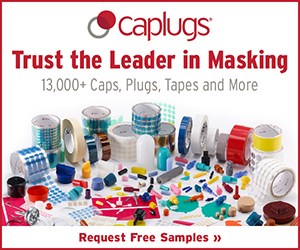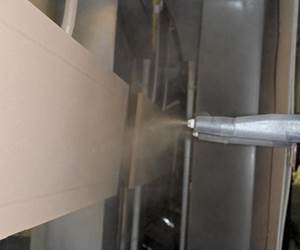Calculating Oven Heat Load Capacity
Please explain how to calculate the heat load capacity of a paint baking oven, using aluminum alloy wheels as an example.
Q. Please explain how to calculate the heat load capacity of a paint baking oven, using aluminum alloy wheels as an example. H.T.
A. Energy consumption in an oven is primarily related to radiant loss through the oven panels; energy required to raise the product, racks and conveyor to temperature; and exhaust losses. To determine the energy use, you will need to calculate these three factors and then add them to get the total.
Panel Loss
To calculate the loss of Btu/h through the oven panels, multiply the total square feet of oven panel surface area by the panel loss factor (see table) and then by the temperature difference between the oven start-up and the controller setting.
| Panel Thickness | Loss Factor |
|---|---|
| 3 inches | 0.40 |
| 4 inches | 0.35 |
| 5 inches | 0.30 |
| 6 inches |
0.25 |
| 8 inches | 0.20 |
Formula: Square feet of oven surface × panel loss factor × temperature rise
Example
Oven Size: 20 × 50 × 10 ft (W × L × H)
Operating Temperature: 300°F
Oven Start-up Temperature: 70°F
Panel Thickness: 4 inches
Oven Surface Area
Sides: 10 × 50 = 500 × 2 sides = 1,000
Ends: 10 × 20 = 200 × 2 ends = 400
Top and bottom: 20 × 50 = 1,000 × 2 = 2,000
Total: 1,000 + 400 + 2,000 = 3,400 sq ft
Temperature Rise
300°F - 70°F = 230°F
Panel Loss
3,400 sq ft surface area × 0.35 panel loss factor × 230°F temperature rise = 273,700 Btu/hr
Product Loading
To calculate the Btu/hr required to support the product loading, multiply the total load (parts, rack, conveyor chain and trolleys) by the specific heat (Btu required per lb °F) by the temperature rise. The factor 0.226 is used for aluminum. Different materials will require a different multiplier, and the table below shows the specific heat values for different metals.
| Metal | Specific Heat |
|---|---|
| Steel | 0.12 |
| Aluminum | 0.226 |
| Iron | 0.175 |
| Zinc | 0.0931 |
| Conveyor | Chain Weight/Ft | Trolley Weight |
|---|---|---|
| Enclosed Track | 3.5 lbs | 0.5 lbs (H-Attach) |
| X348 | 2.14 lbs | 2.34 lbs |
| X458 | 3.14 lbs | 5.18 lbs |
| X678 | 6.39 lbs | 16.5 lbs |
Formula: Total load × specific heat × temperature rise
Example:
Chain: X348
Trolley Centers: 12 inches
Racks: 5 lbs on 12-inch centers
Parts: 5 lbs on 12-inch centers
Line Speed: 10 ft/min
Oven Temperature: 300°F
Oven Start-up Temperature: 70°F
Total Load
Chain Weight: 2.14 + 2.34 = 4.48 lbs/ft
Parts and Racks Load: 5 + 5 = 10 lbs/ft
Total: 4.48 lbs chain and trolleys + 10 lbs parts and racks = 14.48 lbs/ft
Total product load/min: 14.48 lbs/ft × 10 ft/min = 144.8 lbs/min
Product load/hr: 144.8 lbs/min × 60 min = 8,688 lbs/hr
Temperature Rise
300°F - 70°F = 230°F
Btu/Hr
8,688 lbs/hr total load × 0.12 specific heat × 230°F temperature rise = 239,789 Btu/hr
(0.12 is the multiplier used for steel.)
Exhaust Loss
The exhaust loss is determined by multiplying the cu ft/min of exhaust (cfm) by 60 min by 0.075 lbs/cu ft by 0.24 Btu/hr per pound by the temperature rise in °F.
Formula: cfm × 60 × 0.075 × 0.24 × temperature rise
Example:
Exhaust Volume: 2,000 cfm
Set Temperature: 300°F
Oven Start-up Temperature: 70°F
Temperature Rise
300°F - 70°F = 230°F
Exhaust Loss
2,000 cfm × 60 min × 0.075 lbs/cu ft × 0.24 Btu/hr × 230°F temperature rise = 496,800 Btu/hr
Total Energy Use
To determine the total Btu/hr consumed, add the three factors: panel loss, product loading and exhaust loss. In the above examples, this total would be:
273,7000 + 239,789 + 496,800 = 1,010,289 Btu/hr
To determine the actual cost, you must multiply the consumption by the cost for the energy used in the oven. The cost for energy varies widely in different regions. It was an average of about $2.80 per million Btu the week ending August 15, 2012.
Related Content
Heat Up Your Maintenance Plan for Best Oven Performance
Improve efficiency and profitability with a preventive maintenance program for your industrial heating equipment.
Read MoreHow Not to Cure Powder on MDF
Mike Chapman, chief strategic officer at WolfRayet, an industrial oven provider for heat-sensitive substrates, discusses the correct procedures and common pitfalls when curing powder coating on MDF.
Read MorePowder Coat MDF for an Enviable Finished Product
Cabinet maker says powder coating on wood offers more benefits.
Read MoreThe Powder Coating Process
Powder coating is one of the most durable finishes that can be applied to industrial manufactured products, and offers excellent corrosion protection and is very safe because of its lack of volatile organic compounds. To understand the powder coating process you should start with the fundamentals.
Read MoreRead Next
The 2024 Ford Mustang: All the Colors Available
Although Chevrolet has announced the end of the Camaro and Dodge is offering “Last Call” editions of the Charger and Challenger, the Ford Mustang is launching to its seventh generation.
Read MorePowder Coating 4.0: Smarter, Faster, More Efficient and Connected
New tools reduce cost and waste, lower manufacturing footprint of powder coating operations.
Read MoreEpisode 42: An Interview with Robin Deal, Hubbard-Hall
Hubbard-Hall wastewater treatment specialist Robin Deal discusses the latest trends in wastewater management.
Read More


























